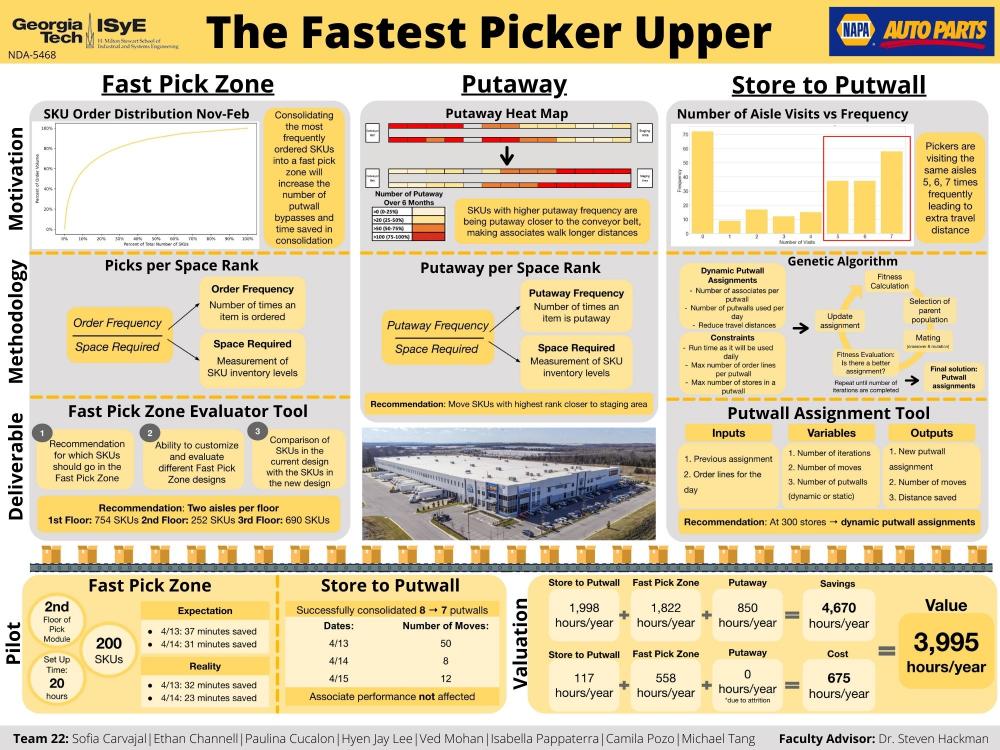Client Context
NAPA Auto Parts (NAPA) is an aftermarket automotive parts provider in North America and is a fully owned subsidiary of the Genuine Parts Company (GPC). NAPA sells over 500,000 unique parts, operates 57 distribution centers, and manages 6,000 NAPA retail stores. In June 2020, NAPA started consolidating multiple smaller distribution centers and opened their newest distribution center (DC) in Nashville, Tennessee, which will serve 300 NAPA retail stores at maximum capacity. The Nashville DC (NTN) currently services 200 retail stores and will be fully operational by the end of May 2021. In addition, NAPA expects to double its labor force from 60 to 120 associates.
Project Objective
NAPA directed the team to take a holistic view of NTN’s operations and evaluate the areas where labor costs could be reduced before the DC is fully operational. Because the DC is new, many processes are still open to change. The team found three opportunities to reduce labor costs: (1) by implementing a dynamic store-to-putwall assignment, (2) by creating a fast pick zone, and (3) by modifying putaway locations. These three design strategies are implementable with NAPA’s current Warehouse Management System. Even though they are fairly simple, together they will make NAPA’s operations more effective.
Design Strategy
Dynamic store-to-putwall assignment means that the number of active putwalls varies daily, based on both the order lines and customers. Currently, NTN uses a static putwall with store assignments changing infrequently. A dynamic putwall is expected to decrease labor costs by reducing picking travel distance in the pick module and reducing the number of associates operating the putwalls..
The store-to-putwall assignment genetic algorithm was backtested on the picking data from January 2021 to measure its performance. The dynamic putwall was able to service January’s volume using four or five putwalls on any given day. During the time frame, an average of 4.55 putwalls were used with 1,500 being the maximum number of order lines assigned to any putwall. There was an estimated 34% decrease in distance traveled within the pick module. 563 moves were made in order to make these changes.
NAPA piloted store-to-putwall recommendations between April 13, 2021 and April 15, 2021. During this time:
NAPA reduced the number of putwalls from eight to seven.
70 putwall moves were made.
13% of picking distance was saved.
Associate performance was not affected
The Fast Pick Zone is a small area where the most frequently ordered SKUs are consolidated. Pickers pick into a tote that contains the SKUs for only one customer at a time, allowing the tote to bypass sortation and consolidation at the putwall. With this Fast Pick Zone, our team also recommends NAPA to buy new, smaller totes in order to increase the number of totes an associate can pick into.
NAPA piloted the Fast Pick Zone from April 5, 2021, to April 15, 2021. During these two weeks, the team worked very closely with the NAPA team to make necessary adjustments before the daily operations began, and met with them every day to discuss results and improvements to be made.
The team recommended moving the top 200 SKUs, based on the picks per space ranking, into an aisle on the second floor. The Fast Pick Zone was a single aisle in size and was placed on floor 2. It took around 20 labor hours to move the 200 SKUs in the fast pick zone, giving NAPA an estimate of the amount of labor needed to move a SKU.
Before the pilot began, the team estimated the expected time saved in consolidation from putwall bypasses using the list of SKUs that NAPA moved into the pilot fast pick zone. The backtesting used order line data from the same day of the week in the previous week for a fair comparison. The expected time saved in consolidation was similar to the actual time saved in consolidation on 4/13/2021. But on 4/14/2021, the expected time saved differed more from the actual time saved. This disparity was attributed to a training gap identified on 4/15/2021 where items were being putaway to their previous location outside the Fast Pick Zone. Table 13 shows the expected versus actual results.
Deliverables
The team will provide NAPA with the following deliverables. The dynamic store-to-putwall assignment tool outputs recommendations for the number of putwalls to use, which tote swaps to make, and the estimated travel distance saved. The fast pick zone tool outputs a list of the recommended SKUs to place in the fast pick zone. The putaway tool outputs the new recommended locations for the SKUs.


